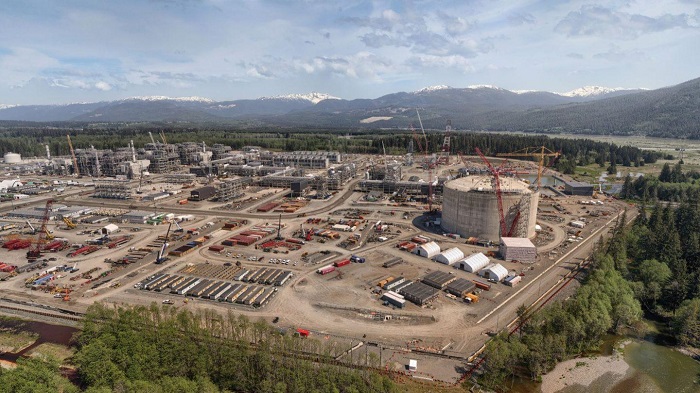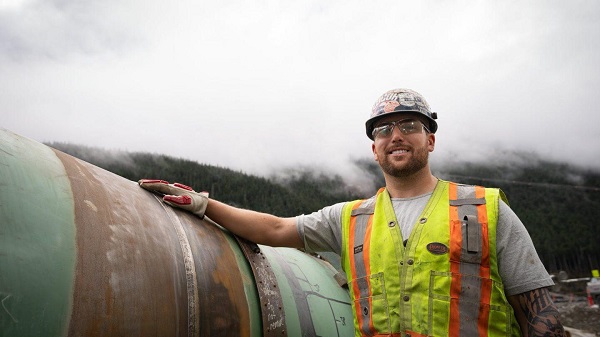Canadian Energy Centre
To reduce emissions, the world needs more LNG: report

The LNG Canada export terminal is about 85 per cent complete. Photo courtesy LNG Canada
From the Canadian Energy Centre
By Deborah JaremkoWood Mackenzie says spending needs to rise by $400 billion over the next decade
An additional $400 billion investment in liquefied natural gas (LNG) projects around the world is needed over the next decade to ensure energy security and achieve emissions reductions, according to a new report by Wood Mackenzie.
Without increased LNG supply, it said Asian countries in particular will continue to rely on high-emitting coal as they grow power generation.
“On a global scale, limited supplies of LNG risks stalling progress towards 2050 net zero targets in the near term,” says the report by Wood Mackenzie and Petronas, one of the joint venture owners of the LNG Canada project.
The fallout from Russia’s invasion of Ukraine rerouted LNG shipments from Asia to Europe, contributing to record coal consumption in 2022, analysts noted.
“A key pillar of the energy transition is to reduce the consumption of coal. A critical step in that transition is to shift power production from coal to much lower-emissions gas. The shift helps drive immediate decarbonization while renewables, energy storage, and other clean energy technologies scale-up.”
Power generation from natural gas reduces emissions by half on average, according to the International Energy Agency (IEA). LNG from Canada can deliver an even bigger decrease, reducing emissions by up to 62 per cent, according to a 2020 study published in the Journal for Cleaner Production.
Global natural gas use is rising, driving increased demand for LNG. The U.S. Energy Information Administration’s latest outlook projects natural gas consumption will rise to 197 quadrillion BTU in 2050, up from 153 quadrillion BTU in 2022.
“Gas can be used to not only replace coal for power generation, but also to provide fuel for blue hydrogen production, and as an essential source of flexibility as electricity grids incorporate increasingly large amounts of intermittent renewable generation,” Wood Mackenzie said.
“Gas also plays a critical role in non-power sectors such as commercial and residential heating, as a feedstock for chemicals and fertilizers, and as an energy source for metals, cement, and other manufacturing processes.”
Canadian LNG has advantages in a lower emission world, the report said.
“Canada’s western ports are ideally positioned to supply growing Asian demand because its shipping routes aren’t dependent on an uncongested Panama Canal. The country is also poised to produce some of the lowest-emission LNG in the world,” Wood Mackenzie said.
The low emissions per tonne of LNG in Canada come from shorter shipping distances to customers, a colder climate, the use of hydroelectricity, and methane emissions reduction from upstream natural gas production.
Once it starts operating in 2025, LNG Canada will have emissions intensity of 0.15 per cent CO2 per tonne, less than half the global average of 0.35 per cent per tonne, according to Oxford Energy Institute.
Proposed Indigenous-led project Cedar LNG would have emissions intensity of 0.08 per cent, and smaller-scale Woodfibre LNG would have emissions intensity of 0.04 per cent.
“The gas and LNG supply and demand mismatch that spawned the current energy crisis and stalled energy transition progress can’t be repeated,” Wood Mackenzie said.
“This will require a long-term commitment to expanding capacity to ensure reliable, increasingly low-emission, and affordable LNG that won’t be upended by future geopolitical and economic disruptions.”
2025 Federal Election
Canada’s pipeline builders ready to get to work

From the Canadian Energy Centre
“We’re focusing on the opportunity that Canada has, perhaps even the obligation”
It was not a call he wanted to make.
In October 2017, Kevin O’Donnell, then chief financial officer of Nisku, Alta.-based Banister Pipelines, got final word that the $16-billion Energy East pipeline was cancelled.
It was his job to pass the news down the line to reach workers who were already in the field.
“We had a crew that was working along the current TC Energy line that was ready for conversion up in Thunder Bay,” said O’Donnell, who is now executive director of the Mississauga, Ont.-based Pipe Line Contractors Association of Canada (PLCAC).
“I took the call, and they said abandon right now. Button up and abandon right now.
“It was truly surreal. It’s tough to tell your foreman, who then tells their lead hands and then you inform the unions that those three or four or five million man-hours that you expected are not going to come to fruition,” he said.

Workers guide a piece of pipe along the Trans Mountain expansion route. Photograph courtesy Trans Mountain Corporation
“They’ve got to find lesser-paying jobs where they’re not honing their craft in the pipeline sector. You’re not making the money; you’re not getting the health and dental coverage that you were getting before.”
O’Donnell estimates that PLCAC represents about 500,000 workers across Canada through the unions it works with.
With the recent completion of the Trans Mountain expansion and Coastal GasLink pipelines – and no big projects like them coming on the books – many are once again out of a job, he said.
It’s frustrating given that this could be what he called a “golden age” for building major energy infrastructure in Canada.
Together, more than 62,000 people were hired to build the Trans Mountain expansion and Coastal GasLink projects, according to company reports.
O’Donnell is particularly interested in a project like Energy East, which would link oil produced in Alberta to consumers in Eastern and Atlantic Canada, then international markets in the offshore beyond.
“I think Energy East or something similar has to happen for millions of reasons,” he said.
“The world’s demanding it. We’ve got the craft [workers], we’ve got the iron ore and we’ve got the steel. We’re talking about a nation where the workers in every province could benefit. They’re ready to build it.”

The “Golden Weld” marked mechanical completion of construction of the Trans Mountain Expansion Project on April 11, 2024. Photo courtesy Trans Mountain Corporation
That eagerness is shared by the Progressive Contractors Association of Canada (PCA), which represents about 170 construction and maintenance employers across the country.
The PCA’s newly launched “Let’s Get Building” advocacy campaign urges all parties in the Canadian federal election run to focus on getting major projects built.
“We’re focusing on the opportunity that Canada has, perhaps even the obligation,” said PCA chief executive Paul de Jong.
“Most of the companies are quite busy irrespective of the pipeline issue right now. But looking at the long term, there’s predictability and long-term strategy that they see missing.”
Top of mind is Ottawa’s Impact Assessment Act (IAA), he said, the federal law that assesses major national projects like pipelines and highways.
In 2023, the Supreme Court of Canada found that the IAA broke the rules of the Canadian constitution.
The court found unconstitutional components including federal overreach into the decision of whether a project requires an impact assessment and whether a project gets final approval to proceed.
Ottawa amended the act in the spring of 2024, but Alberta’s government found the changes didn’t fix the issues and in November launched a new legal challenge against it.
“We’d like to see the next federal administration substantially revisit the Impact Assessment Act,” de Jong said.
“The sooner these nation-building projects get underway, the sooner Canadians reap the rewards through new trading partnerships, good jobs and a more stable economy.”
Canadian Energy Centre
First Nations in Manitoba pushing for LNG exports from Hudson’s Bay

From the Canadian Energy Centre
By Will Gibson
NeeStaNan project would use port location selected by Canadian government more than 100 years ago
Building a port on Hudson’s Bay to ship natural resources harvested across Western Canada to the world has been a long-held dream of Canadian politicians, starting with Sir Wilfred Laurier.
Since 1931, a small deepwater port has operated at Churchill, Manitoba, primarily shipping grain but more recently expanding handling of critical minerals and fertilizers.
A group of 11 First Nations in Manitoba plans to build an additional industrial terminal nearby at Port Nelson to ship liquefied natural gas (LNG) to Europe and potash to Brazil.
Robyn Lore, a director with project backer NeeStaNan, which is Cree for “all of us,” said it makes more sense to ship Canadian LNG to Europe from an Arctic port than it does to send Canadian natural gas all the way to the U.S. Gulf Coast to be exported as LNG to the same place – which is happening today.
“There is absolutely a business case for sending our LNG directly to European markets rather than sending our natural gas down to the Gulf Coast and having them liquefy it and ship it over,” Lore said. “It’s in Canada’s interest to do this.”
Over 100 years ago, the Port Nelson location at the south end of Hudson’s Bay on the Nelson River was the first to be considered for a Canadian Arctic port.
In 1912, a Port Nelson project was selected to proceed rather than a port at Churchill, about 280 kilometres north.
The Port Nelson site was earmarked by federal government engineers as the most cost-effective location for a terminal to ship Canadian resources overseas.
Construction started but was marred by building challenges due to violent winter storms that beached supply ships and badly damaged the dredge used to deepen the waters around the port.
By 1918, the project was abandoned.
In the 1920s, Prime Minister William Lyon MacKenzie King chose Churchill as the new location for a port on Hudson’s Bay, where it was built and continues to operate today between late July and early November when it is not iced in.
Lore sees using modern technology at Port Nelson including dredging or extending a floating wharf to overcome the challenges that stopped the project from proceeding more than a century ago.
He said natural gas could travel to the terminal through a 1,000-kilometre spur line off TC Energy’s Canadian Mainline by using Manitoba Hydro’s existing right of way.
A second option proposes shipping natural gas through Pembina Pipeline’s Alliance system to Regina, where it could be liquefied and shipped by rail to Port Nelson.
The original rail bed to Port Nelson still exists, and about 150 kilometers of track would have to be laid to reach the proposed site, Lore said.
“Our vision is for a rail line that can handle 150-car trains with loads of 120 tonnes per car running at 80 kilometers per hour. That’s doable on the line from Amery to Port Nelson. It makes the economics work for shippers,” said Lore.
Port Nelson could be used around the year because saltwater ice is easier to break through using modern icebreakers than freshwater ice that impacts Churchill between November and May.
Lore, however, is quick to quell the notion NeeStaNan is competing against the existing port.
“We want our project to proceed on its merits and collaborate with other ports for greater efficiency,” he said.
“It makes sense for Manitoba, and it makes sense for Canada, even more than it did for Laurier more than 100 years ago.”
-

 Alberta11 hours ago
Alberta11 hours agoGovernments in Alberta should spur homebuilding amid population explosion
-

 Automotive2 days ago
Automotive2 days agoCanadians’ Interest in Buying an EV Falls for Third Year in a Row
-

 2025 Federal Election1 day ago
2025 Federal Election1 day agoAs PM Poilievre would cancel summer holidays for MP’s so Ottawa can finally get back to work
-

 armed forces21 hours ago
armed forces21 hours agoYet another struggling soldier says Veteran Affairs Canada offered him euthanasia
-

 conflict20 hours ago
conflict20 hours agoWhy are the globalists so opposed to Trump’s efforts to make peace in Ukraine?
-

 Entertainment2 days ago
Entertainment2 days agoPedro Pascal launches attack on J.K. Rowling over biological sex views
-

 International10 hours ago
International10 hours agoHistory in the making? Trump, Zelensky hold meeting about Ukraine war in Vatican ahead of Francis’ funeral
-

 conflict2 days ago
conflict2 days agoTrump tells Zelensky: Accept peace or risk ‘losing the whole country’









